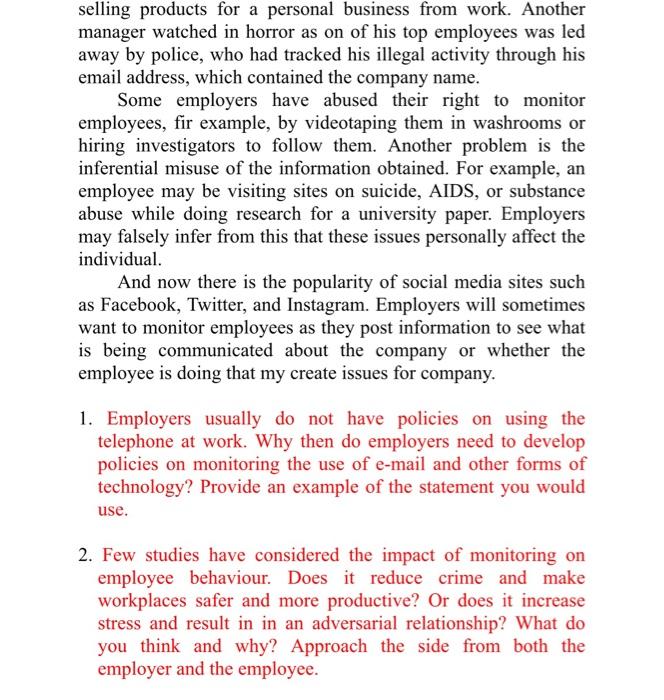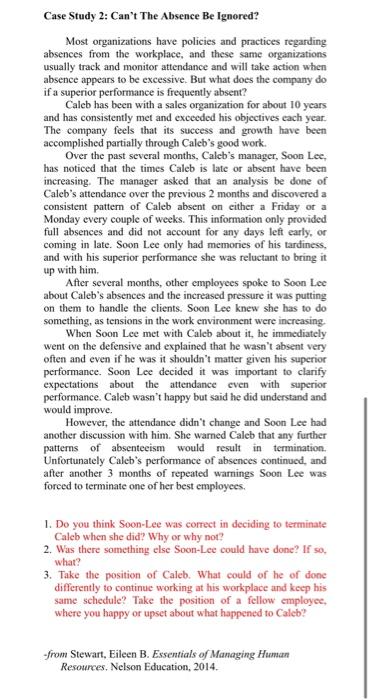Assignment \#2 Using the chapter and PowerPoint as a guide and doing your own research, individually, please read the following cases and provide answers to the case questions. Each response is worth 5 marks and should clearly answer the question in sentence format. Please use research and provide references to validate your answer. Case Study 1: What About My Privacy? Read the following Case studies and using your notes, common sense, real world experience and any online material you wish develop in-depth answers to both of these scenarios. What about my privacy? There are two sides to the issue of workplace privacy. The employee side holds that employees have the right to privacy and that employers should respect and trust their employees. The employer side holds that the workplace is a public environment and that the organization is responsible for the actions of its employees, and for their interactions with clients, visitors, and other employees. Many companies monitor email, voice mail and employee computer use. Most employee monitoring is perfectly legal. The general legal view is that computers, telephones, and so on are company property, and that employees should not be using them for personal reasons. Companies can trace deleted emails and voice mails, special software can track internet use, and wireless video cameras are small enough to look like buttons or pinholes. More and more employees are using technology, and this makes it easier to monitor their work. Even Bill Gates was caught; his private emails being using in a case in the Microsoft antitrust hearings in the United States. Organizations monitor employees in order to deter crime, protect hearings in United States. Organizations monitor employees in order to deter crime, protect business secrets, and ensure a safe and equitable workplace. selling products for a personal business from work. Another manager watched in horror as on of his top employees was led away by police, who had tracked his illegal activity through his email address, which contained the company name. Some employers have abused their right to monitor employees, fir example, by videotaping them in washrooms or hiring investigators to follow them. Another problem is the inferential misuse of the information obtained. For example, an employee may be visiting sites on suicide, AIDS, or substance abuse while doing research for a university paper. Employers may falsely infer from this that these issues personally affect the individual. And now there is the popularity of social media sites such as Facebook, Twitter, and Instagram. Employers will sometimes want to monitor employees as they post information to see what is being communicated about the company or whether the employee is doing that my create issues for company. 1. Employers usually do not have policies on using the telephone at work. Why then do employers need to develop policies on monitoring the use of e-mail and other forms of technology? Provide an example of the statement you would use. 2. Few studies have considered the impact of monitoring on employee behaviour. Does it reduce crime and make workplaces safer and more productive? Or does it increase stress and result in in an adversarial relationship? What do you think and why? Approach the side from both the employer and the employee. Case Study 2: Can't The Absence Be Ignored? Most organizations have policies and practices regarding absences from the workplace, and these same organizations usually track and monitor attendance and will take action when absence appears to be excessive. But what does the company do if a superior performance is frequently absent? Caleb has been with a sales organization for about 10 years and has consistently met and exceeded his objectives each yearThe company feels that its success and growth have been accomplished partially through Caleb's good work. Over the past several months, Caleb's manager, Soon Lee, has noticed that the times Caleb is late or absent have been increasing. The manager asked that an analysis be done of Caleb's attendance over the previous 2 months and discovered a consistent pattern of Caleb absent on either a Friday or a Monday every couple of weeks. This information only provided full absences and did not account for any days left early, or coming in late. Soon Lee only had memories of his tardiness, and with his superior performance she was reluctant to bring it up with him. After several months, other employees spoke to Soon Lee about Caleb's absences and the increased pressure it was putting on them to handle the clients. Soon Lee knew she has to do something, as tensions in the work environment were increasing. When Soon Lee met with Caleb about it, he immediately went on the defensive and explained that he wasn't absent very often and even if he was it shouldn't matter given his superior performance. Soon Lee decided it was important to clarify expectations about the attendance even with superior performance. Caleb wasn't happy but said he did understand and would improve. However, the attendance didn't change and Soon Lee had another discussion with him. She warned Caleb that any further patterns of absenteeism would result in termination. Unfortunately Caleb's performance of absences continued, and after another 3 months of repeated warmings Soon Lee was foreed to terminate one of her best employees. 1. Do you think Soon-Lee was correct in deciding to terminate Caleb when she did? Why or why not? 2. Was there something else Soon-Lee could have done? If so, What? 3. Take the position of Caleb. What could of he of done differently to continue working at his workplace and keep his same schedule? Take the position of a fellow employee, where you happy or upset about what happened to Caleb? from Stewart, Eileen B. Essentials of Managing Human Resources, Nelson Education, 2014









